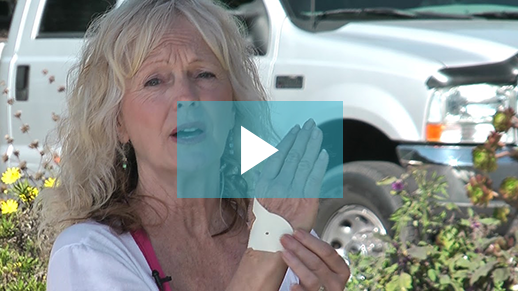Carpal Tunnel Surgery
Article Authored by Doctor Jerome H. Grossman, MD
Co-Founder of First Hand Medical and Former Director of Harvard’s Kennedy School Health Care Delivery Policy Program
https://www.mycarpaltunnel.com/medical-experts/doctor-jerome-h-grossman-md/
“ My Father had Carpal Tunnel Surgery and never improved, I had to find a different way when I got Carpal Tunnel Syndrome”
Diane
Professional Musician
Los Angeles, California
Carpal Tunnel Surgery is done under twilight anesthesia. The drugs cause temporary amnesia, so it feels like one has been completely knocked out. Even though general anesthesia is not administered, when the patient awakes they cannot remember any of the events that have taken place during the surgery. Through an incision on the wrist, the carpal ligament is severed to relieve the pressure on the median nerve – Hence, the phrase “Carpal Tunnel Release Surgery”. The incision is sutured closed with the expectation that the ligament tissue will scar back together over several months leaving more space.
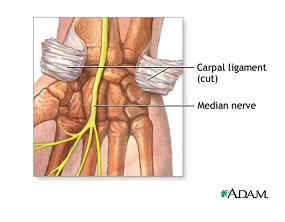
Cost of surgery and rehabilitation is in the range of $5,000 to $10,000 with some improvement achieved in over 70% of cases. Full restoration is achieved in less than 60% of surgeries. Downtime and rehabiliation generally range from six weeks to three months, but can take over a year, depending on how many lingering symptoms result and the degree of scar tissue formation as this primary ligament in the hand heals back together. Scar tissue formation during recovery from surgery is unpredictable and sometimes results in less space in this narrow anatomical passage of the wrist after the carpal tunnel surgical procedure, causing even more discomfort and numbness after surgery. This complication is only reported in less than 15% of surgical procedures.
It is common for people recovering from the carpal tunnel surgical procedure to experience some permanent loss of grip strength, a perduring loss of lifting strength in the wrist/forearm, a nagging loss of full range of motion of the hand and wrist after surgery and lingering tenderness at the incision. This is due to severing the Transverse Carpal Ligament and then relying on this important ligament at the base of the hand to scar or heal back together. The purpose of the Transverse Carpal Ligament is to wrap around the hand and wrist and helps hold the many small bones of the hand and wrist securely together (article is continued below).
Watch a Video Interview with Surgical Nurse Kathy speaking about Carpal Tunnel Treatment Options
and the risks of Surgery.
Kathy talks about symptoms and treatments for Carpal Tunnel Syndrome and how she was able to avoid Carpal Tunnel Surgery. This Surgical Nurse discusses the risks and common complications associated with this Carpal Tunnel Release Surgery.
Carpal Solution Therapy was developed by a Doctor, is patented medical technology and is FDA registered.
Patient Success is over 97%!
Find out why Neurologist say that Carpal Solution Therapy is the Best First Line of Defense for Carpal Tunnel Syndrome
Call: 1-800-798-5210 to Learn More and Order or click on Order Today
There are over 27 bones in the hand and wrist nested together in a careful combination to enable the miraculous dexterity, movement and strength of the hand, fingers and wrists. Since we are born with this remarkable ability, most of us take it for granted that these bones move and work together seamlessly in full range of motion and without complications. These bones are all held together by fascia tissue, cartilage, ligaments, tendons and muscle. The single largest and strongest ligament of the hand, theTransverse Carpal Ligament binds all of these components together. When one considers the number of bones and complicated tight arrangement of blood vessels, nerves, ligaments and soft tissue cushioning and controlling the dexterous movement of these multiple bones, it is no wonder that the act of trying to adjust this remarkable combination by mere mortals often goes awry. Interestingly, it is this important ligament, the Transverse Carpal Ligament, that is severed during the surgical procedure known as Carpal Tunnel Release Surgery.
This is why most medical professionals and insurance companies insist that credible non-invasive therapies are tried before resorting to surgery. Surgery for Carpal Tunnel is considered as a last resort. Contrary to what many people are led to believe, Carpal Tunnel Surgery is not a permanent fix.
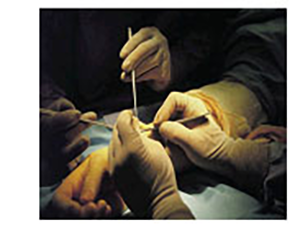
Most patients do not have the stamina, time, money, resilience or patience to endure multiple surgeries on the same hand. Also, build-up of scar tissue from repeated cutting of this ligament often risk constricting the tight space in this narrow passage further, contributing to worse CTS symptoms, limiting range of motion and further weakening the grip of the hand and the lifting power of the wrist. You can learn more about natural Carpal Tunnel Relief Video options and watch an interview with Dr. Robbin discussing Carpal Tunnel Syndrome in a compelling video program hosted on YouTube and viewed on the link, Carpal Tunnel Treatment .
John had Surgery on Both Hands, but still had Thumb Pain, Wrist Pain and Could Not Sleep.

“After having two Carpal Tunnel Syndrome Surgeries, I still was not able to sleep at night because my hands were throbbing and hurting.
It is really hard to function all day when you don’t sleep. The Pain was in both of my thumbs and both wrists. It is also hard do my work.
After using the Carpal Solution Treatment the first night, I felt the difference. I was able to sleep. I have been using it for nine weeks now and believe me, it works. No thumb pain, No Wrist pain, the sleep feels so good, and my hands work like they used to.”
John – Locksmith Engraver,
Carpal Tunnel Cured St. Louis, Missouri.
Because of the risks associated with the invasive nature of surgery, most surgeons, neurologists, family physicians, hand therapists, medical insurance companies and healthcare professionals generally advise patients to exhaust clinically documented conservative treatments for Carpal Tunnel Syndrome before considering surgery. The Carpal Solution is one of the best conservative therapies, because it is all natural, bears no risks and can be done in the convenience of home during sleep.
People considering surgery often worry about managing the downtime, the risks of potential complications, lingering symptoms during the recovery from surgery, the likelihood of permanent loss of grip strength in their hand and the loss of range of motion in the hand and wrist after surgery. Rehabilitations can be long, time consuming and painful.
Recovery from Carpal Tunnel Surgery is not as simple as it is sometimes represented.Many people elect not to undergo surgery on their other hand after having it on one hand. With a 60% patient satisfaction rate – it is one of the lowest in healthcare for surgical procedures. Most people want to have at least a 90% plus success rate before taking on the risks, downtime and long rehabilitation associated with almost any surgery.
For a chronic condition brought on by repetitive stress activities and often by metabolic swelling like CTS, it has a high probability of reoccurring. Most people prefer to find a reliable, convenient, safe and natural therapy that does not involve the risks, downtime, expense and the potential for complications of a surgical procedure. Repeating the drama of surgery is just not a pleasant experience for a patient with any condition, especially after one has endured the ramifications of Carpal Tunnel. There is no permanent cure for CTS, even after a successful surgical procedure, the symptoms will likely flare up again in time, if you keep doing the same activities. That is why you need to seek an all natural carpal tunnel treatment that is convenient, safe and has no downtime nor risks associated with it.
Watch Linda share her experience with a failed Surgery. She tells how she finally got relief from the Home Stretching Treatment Known as the Carpal Solution.
Most people can avoid the risks, the downtime and painful rehabilitation by using the Carpal Solution Stretching Therapy before they resort to surgery.
Susan is an Interior Design Expert in Tucson, Arizona and now is a retired senior who had Carpal Tunnel Surgery performed on both hands. The left hand was done nine years ago by one surgeon and the right hand was done just four years ago by a different surgeon.
The Surgery was a success at least initially. All of her Carpal Tunnel Symptoms went away for about 8 years on the Left Hand, but when they came back she started dropping things and could not lift many objects that used to be routine such as a carton of milk to do pain and lack of strength. Susan was surprised to have Carpal Tunnel Syndrome come back. She thought Carpal Tunnel Surgery was a permanent fix?
The surgeon never said the symptoms would come back in less than 8 years.
She did not want to do surgery again, so she looked online for an alternative carpal tunnel treatment and found The Carpal Solution Treatment.
She ordered it and tried it out and it worked great for her Left hand even after a surgical procedure.
Then the Carpal Tunnel Symptoms came back in her right hand after just 4 years post-surgery.
She was disappointed that the symptoms came back in her Right Hand even quicker. This time she knew what to do. Again she ordered the Carpal Solution for the Right Hand and again her symptoms were put in remission within 6 weeks and she was able to get back to her normal life.
Watch Susan from Tucson, Arizona tell her Carpal Tunnel journey by clicking on the arrow in the picture below.
If you haven’t had Carpal Tunnel Surgery. You should try the Carpal Solution Treatment first.
If you have had Carpal Tunnel Surgery and your symptoms got worse like Linda, the Retail Merchandiser, or if you had a successful surgery, but the symptoms came back, Like Susan, the Interior Designer in Arizona – you can still turn to a reliable natural stretching treatment like the Carpal Solution Treatment.
It is good to listen to patients who have real experience with surgery, but it is also important to consider what expert orthopedic surgeons have found when they study the outcomes of Carpal Tunnel Surgery.
Expert Medical Opinion From Leading Orthopedic Surgeons Is Important to Consider Before You Submit to the Risks of Carpal Tunnel Surgery.
Carpal Tunnel Surgery outcomes are well documented by Expert Orthopedic Surgeons and Medical Professionals at top universities around the world. The results leave more questions than answers about Carpal Tunnel Surgery. Many Patients require second surgeries, there are a lot of potential complications that are far too common. Rehabilitation can take as long as a year and downtime and hand dysfunction can disrupt your earnings and your lifestyle for much longer than is often presented by some surgeons. As you evaluate your decision for your first line of treatment for Carpal Tunnel Syndrome, you should definitely consider the research done by some of the leading orthopedic surgeons in the world in the technical papers presented below.
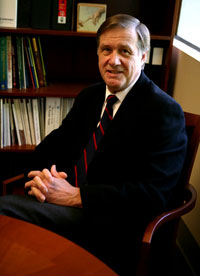
By: NF Jones, MD Professor of Orthopedic Surgery and Director of UC Irvine Hand Center published the following information entitled:
Revision Surgery for Carpal Tunnel Release
BACKGROUND: Carpal tunnel release is one of the most frequently performed hand operations. However, persistent, recurrent, or completely new symptoms following carpal tunnel release remain a difficult problem.
METHODS: A retrospective review of the surgical findings and outcomes of 50 consecutive patients who had undergone 55 revision carpal tunnel operations was performed.
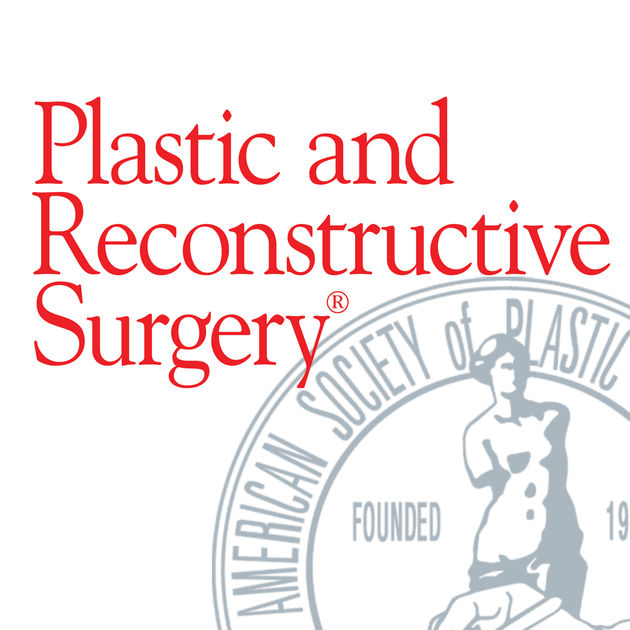
The initial carpal tunnel release was an endoscopic technique in 34 hands and an open technique in 21 hands.
Thirty-four hands continued to have persistent symptoms, 18 hands had recurrent symptoms, and three hands had completely new symptoms generated from the original release surgical procedure.
Surgical re-exploration revealed incomplete release of the transverse carpal ligament in 32 patients.
Circumferential fibrosis around the median nerve was found in all patients.
Forty-six percent of patients with recurrent symptoms had slight palmar subluxation of the median nerve.
External neurolysis was performed in 41, epineurectomy was performed in 15, synovial or hypothenar fat flap coverage was performed in eight, and radial forearm adipofascial flap coverage was performed in three hands.
Some symptomatic improvement following revision surgery was achieved after open carpal tunnel release was slightly better (90 percent) compared with after endoscopic carpal tunnel release (76 percent).
Complete relief of symptoms following revision surgery was similar after open (57 percent) or endoscopic (56 percent) techniques.
(In other words less than 57% reported complete relief after the revision surgery)
Ten patients (20 percent) showed no improvement after the revision surgery.
Five patients (10 percent) required a third operation because symptoms worsened sufficiently to justify a third surgical procedure.
CONCLUSIONS: Patients have issues following Carpal Tunnel Release Surgery due to several factors:
(1) They continue to have persistent symptoms after carpal tunnel release because of incorrect diagnosis or incomplete release of the transverse carpal ligament;
(2) They develop recurrent symptoms caused by circumferential fibrosis; (the thickening and scarring of connective tissue around the median nerve, usually as a result of original release surgery. It is common for this scarring of connective tissue to limit free movement without discomfort or pain.) or
(3) (The patient develop completely) new symptoms, which usually implies iatrogenic injury (adverse effects that happen with invasive procedures like carpal tunnel release surgery) to branches of the median nerve (that happened due to complications arising from the first surgical release procedure).
https://www.ncbi.nlm.nih.gov/pubmed/22090245 Plastic and Reconstructive Surgery
https://meeting.handsurgery.org/abstracts/2012/22.cgi American Association of Hand Surgeons
Parenthetical interpretation is added for clarity and to aid to a laymen more readily understanding the surgeons technical jargon.
Potential Complications From Carpal Tunnel Surgery Summarized in comfortable terms you can understand easily
https://www.mycarpaltunnel.com/carpal-tunnel-surgery/complications-and-risks.shtml
Please consider the information supporting the long hard journey you could face with a Carpal Tunnel Surgical Procedure in the Medical Research Paper presented by Doctor Kevin Chi Chung, MD (expert in plastic surgery, hand surgery and orthopedic surgery) in the publication: Hand referenced below: (you will also find links that provide the detailed information
Current Status of Outcomes Research in Carpal Tunnel Surgery
Abstract

“However, it should be noted that many patients in this cohort still have residual symptoms. A mean postoperative score at 3 months of 2.0 indicated that despite a great deal of improvement, this cohort of patients still complained of quite a bit of symptoms relating to CTS.”
https://www.ncbi.nlm.nih.gov/pmc/articles/PMC2517327/
Published in Hand the Publication of the American Associates for Hand Surgery by Kevin C. Chung, MD
Hand. 2006 Jun; 1(1): 9–13.
Published online 2006 Jul 25. doi: 10.1007/s11552-006-0002-3
Even after 3 months many patients still complain about lingering symptoms and loss of grip strength and tenderness at the point of incision. Carpal Tunnel Surgery has unclear outcomes according to medical experts like Dr. Chung, MD.

Professor at University of Michigan Medical School
Specialties: Plastic Surgery, Hand Surgery (Orthopedic Surgery)
Area of Practice: Hand and upper extremity surgery: rheumatoid arthritis, congenital hand problems, spinal cord injuries, nerve injuries, complex fractures and trauma, microsurgery
There is no reason to submit to the uncertainty, potential complications and long rehabilitation, downtime and repeat surgical procedures associated with Carpal Tunnel Surgery.
Do not rush into a surgical procedure with scare tactics of “nerve damage” that are often thrown around with little justification. “Nerve Damage” from Carpal Tunnel Syndrome is rare and takes years of excruciating pain before the nerve is damaged. Once the Nerve is damaged it is permanent, but again it is rare. Consider the opinion of experts on Surgery above before you risk the health and performance of your hands.
The Carpal Solution Nighttime Stretching Treatment offers a way to treat you carpal tunnel at home with a 97% success rate,
With no downtime and with no complications. This is why Neurologists call it the best first line of treatment for Carpal Tunnel Syndrome.
The Carpal Solution Natural Stretching Treatment Jump-Starts your Body’s Natural Healing Process.


